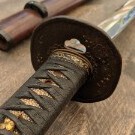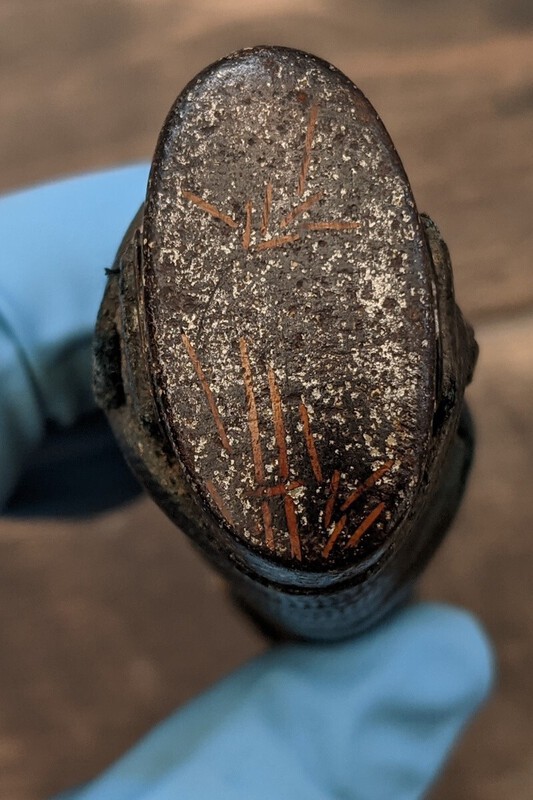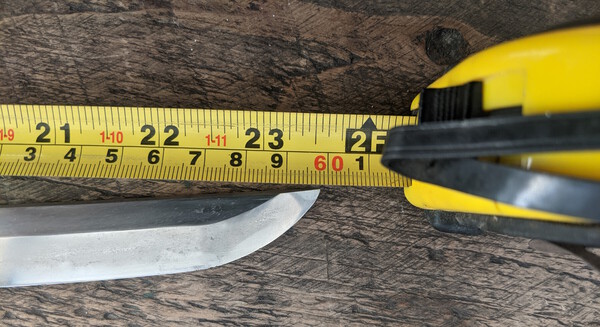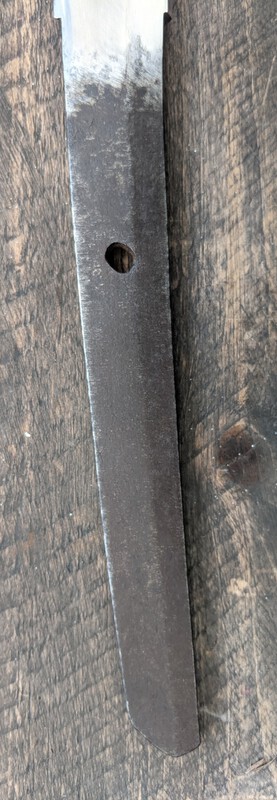-
Posts
228 -
Joined
-
Last visited
Everything posted by George KN
-
3. The leaf tsuba (my personal favourite, and why I bought the lot to begin with): Any guesses what the spikes are meant to represent?
-
2. The wonky tsuba (the main hole seems to be off-centred for some reason?, and its got quite the dent in it which certainly isn't helping):
-
1. The chromosome tsuba (I really don't know what the shapes are meant to represent, but it is actually much more attractive in person than in the pictures):
-
Hi guys, I have made another thread about the Tantō here: £50 Tantō/Kaiken/Kitchen Knife But in the same auction I bought that blade, I also picked up four tsuba and two seppa (for less than £100 I might add): (I have numbered them for ease of discussion) Although I know very little about tsuba, these guys look like they have had a rough time - and I very much want to ensure they are cared for properly. Before I go into my preservation plan, can anyone tell me anything about them please? I'm can't even begin to guess their age or school. I will shortly attach more detailed images.
-
Hi guys, I do enjoy my bargain hunting (or more specifically, saving things from people that don't appreciate them enough) - and I managed to buy this blade in a UK auction, for a full purchase price of £50 (including delivery): It was sold as a Tantō, with absolutely no other information, in an auction that included 12+ Japanese kitchen knives. Concerningly, this blade also came with kitchen knife a handle (that doesn't fit!). So my first concern, this isn't a kitchen knife right? I own a Katana and a Wakizashi, and have never seen a Tantō in person before. I can however tell whatever it really is, is handmade and likely genuine, with a beautiful hamon and hada - something I couldn't actually see properly in my other blades due to them being out of polish. The blade also has a rather obvious kizu, and the aging of the nagako nakago is also fairly telling (unsigned though): Apart from whether this is a Tantō, a Kaiken, or a kitchen knife, can anyone tell me anything else about its age/design etc? Thanks, and looking forward to hearing your thoughts, George P.S. I also bought some Tsuba in the same auction, but I'll put those in a separate thread here: Bargain Hunt Tsuba
-
@vajo, thank you for quick reply, I just checked out their website too, and it looks like you are totally right! You have just saved me from wasting quite a bit of money - much appreciated
-
Hi, I am looking at potentially buying this Katana in the UK, although details are really thin on the ground, but I get the feeling could be a WW2 blade. The seller can't tell me much other than it is 94cm in total length, 70cm blade length, and they can't get the hilt off meaning I have no idea what the tang looks like. Does the hamon on the blade look fake to anyone else? And does anyone please recognise the symbol on the Habaki? I am assuming it is machine made - but torn because it potentially could be a really cheap buy (~£150), but it does seem quite a gamble. Any thoughts are very welcome! George
-

Two blades I'm looking to buy, but unsure of age / signature
George KN replied to George KN's topic in Translation Assistance
Thank you @raaay & @SteveM, much appreciated! I'll attach some other images for your perusal - this is the first sword: Does its shape also fit with not actually being a 17th century blade? It is definitely interesting the auction called it a 20th century one if the signature states otherwise... I do like the hamon on it (and it was actually my favourite of the two before I learnt it could be gimei... ) What I do find surprising is that the second blade seems to be a wartime one! Its Koshirae isn't anything like the other wartime ones I've seen: With my rather limited knowledge, I did find it interesting that the ray skin wrap didn't have any larger nodes, and that the wrap in general seems to be in a bit of a state... So I'm assuming its koshirae has been replaced since? (or were some wartime blades made this way?) But thank you again for helping with the signature! -
Hi, I'm hoping someone might kindly please be able to translate at least one of the two blades I'm looking at possibly buying (I'm a newish collector, and only have two mumei swords, so this hasn't been an issue before). The first is described as a 60cm 20th century blade, with no details as to the smith or its history - I suspect it may actually be a wakizashi rather than a katana from the length of the Nakago, but I'm unsure if that age estimate is correct?: And the second sword, described as a Meiji katana - sorry about the quality of the images, I'll try and get the seller to send me a better one: Bonus question for anyone nice enough to help me out here, but does the second swords tang look a little bit uneven to you? I'm unsure what would cause that? I guess my main concerns with these are what their age is, whether they are legitimate antiques, and whether they are gimei, although I have no idea if you can even tell that from these pictures. Many thanks, George
-
He hasn't done what I think he's done right? Right?!
-
Hi all, had a really good chat over the phone with Paul today (thanks again for that!), and I'm feeling a lot more confident about both swords, and collecting nihonto in general! Honestly its just a little daunting finding out just how much you *don't* know about a topic, but I already know a lot more than I did yesterday, and I'm very much looking forward to learning yet more again in the future. For those following on about the Wakizashi size debate, I also found an old thread that had some related comments to sword sizes, so it looks like I'm far from the first to be in this situation: Also thanks @Paz - as a novice it really is quite hard to know how to price these things (I've looked at many examples, but it's still difficult for me to know the difference between a £1,000 and £5,000 sword, and even £900 is a lot of money for me to spend on something), so its comforting to hear people say it was a decent deal.
-
Thanks guys for the comments, and @paulb, I wasn't expecting to meet someone that had seen the blades in person on here, let alone the very person that evaluated them, so that's a pleasant surprise! I'd very much like to take you up on your offer and learn more about either blade and the wider world of nihontō collecting - I'm still very much trying to find my feet here. I should also add I continue to be delighted by the longer katana, it really is beautiful to handle and observe - the amount of craftsmanship in the blade and koshirae is on a completely different scale to anything else I have the honour to possess (which considering most of my other possessions are either computer related, or a few antique firearms, it really isn't much of a contest). I can also very much appreciate the chisa-katana / o-wakizashi, although it is in what feels like poorer fittings: With regards to the chisa-katana / o-wakizashi debate though, as I understand it then, there are few potential options (very much speculation, but partly based on what Paul said and what I have read here: https://markussesko....08/11/the-wakizashi/) 1. It is a relatively new blade, after the laws on wakizashi sizes stopped mattering (this seems unlikely considering it was previously purchased in an auction in the 1950s, and Paul has already stated it is likely older). 2. It was made during the time of the sword-laws, but was used as a primary weapon by a short Samurai and therefore would be considered a chisa-katana (this would explain the katana fittings). 3. It was made during the time of the sword-laws, but was made for a civilian with special permission or an outlaw without as a primary weapon (the linked article spoke more about this, and it would also explain the katana fittings and perhaps why they were poorer quality?). 4. It was made during the time of the sword-laws, but made as a secondary weapon for a Samurai that had special permission and wanted a particularly long secondary weapon, an o-wakizashi (although if this is the case, and the sword is literally 60cm long, they are basically carrying around two katana, so I'm not sure what the benefit is since it can't be used in a smaller spaces like a wakizashi is apparently for?). 5. It was made before the sword-laws in 1658, when the sizes for wakizashi and katana weren't fixed, so could be any number of other options (but this seems less likely based on Paul's estimated age of the blade). Have I got those right? And do we think the koshirae is actually original to the sword?
-
Haha, thanks @Jon, it did make me chuckle. @ROKUJURO, interesting thread, but sadly I doubt the auction would ever give a refund - they very much work on the idea that information is advisory and not a guarantee. It does feel weird that it is almost exactly on the boundary between Katana/Wakizashi though. Again, probably just my ignorance, but could it be a Kodachi (https://www.martiala...whats-the-difference)? I've read some articles saying they were exactly 60cm long... Alternatively, any estimates on the age of both of them? Edit: I've also heard the term Ko-Katana thrown around a bit when researching large Wakizashi- what's the difference between a Ko-Katana and an O-Wakizashi? Edit 2: Just found this great article, which has given me a lot to think about: https://markussesko....08/11/the-wakizashi/
-
Thanks @ROKUJURO, @Brian, and @Geraint for your replies, I double checked the measurement, and I think it unfortunately is just under 60cm. Its mildly annoying though as the auction did advertise it as a katana, and even said they had someone come in to look at the collection. Was the 60.6cm Katana/Wakizashi limit always the same throughout all the periods? Or did it change with time or by region? Here is how it was described - any other glaring errors?: A Katana possibly Mino in Koshirae. Sugata: Shinogi-Zukuri Iori-mune with shallow tori-zori Nagasa: 60cm Motohaba: 2.8cm Sakihaba: 2cm Kasane: 7mm Hada: difficult to determine in current polish but appears itame Hamon: Mino style gunome midare with some togari-ba. Broad nioi-guchi with very bright patches of nie. Some sunagashi near the hamachi Kissaki: Chu kissaki with small kaeri and hakikake Nakago: Ubu, one mekugi ana, kurijiri katte-sagari Yasurimei Koshirae: blue tape bound same tsuka (damaged). Good quality round iron tsuba pierced thin plate with sakura mon and signed Tadatsugu . Black lacquered saya (damaged with lacquer loss.) Provenance: purchased in a local UK auction in 1952 Also @Jon, I read in a different thread you had decided to buy a papered and polished sword, congrats! (Probably far less of a gamble than accidentally ending up with a Wakizashi )
-
So I bought these two katana in a UK auction, and they've finally arrived! Sure, the auction provided some details. but both swords are mumei and have no papers, and I've learnt to not trust auctions, so I would very much like your opinions on them. I was really surprised by how different the two blades are - one has a blade length of 66cm, and the other of 60cm, but the difference in weight surprised me. Also, although I'm mostly asking about the blades here (I'll ask about the other parts in another thread), the quality of the tsuka between the two is night and day. Firstly, can anyone confirm these are indeed genuine antique, handmade Japanese katanas? Secondly, any additional information on them would be great! Age, swordsmith, style, etc - all the good stuff! At least without having any signatures I don't need to worry about them being gimei Thirdly, I paid £900 each (including auction fees and delivery), so £1,800 total for these. I've never even held one before, and you don't see them for sale in the UK very often, so is this a lot? My gut feeling after actually holding them is that I may have got a good deal with the long katana, but overpaid for the smaller one? I'll also add more pictures for your perusal, George
-
Ah I'm sorry to hear that. If it makes you feel better the auction fee was like an extra 28% on top of the asking price, and I think the items had a reserve, so it wasn't as cheap as it looked...
-
Hi Geraint, Thanks for verifying my gut feeling - after seeing those pictures I instead went for two others, which I'll ask this forums advice on as soon as they actually get here (delivery after auctions takes so long!) My bad on the name too, good to meet you, George
-
This is the second time I've seen a sword in this forum from a recent auction in the UK - I was very, VERY, tempted to bid on this one when it came on, as I was looking to buy my first Katana, and it had a beautiful tsuba. And I still think it is a beautiful sword, but when I asked for pictures there looked to be pitting in the blade I personally didn't know how to fix, so I didn't end up bidding... Out of curiosity, since I was so close to buying it, are these fatal flaws? Can they be repaired? And if anyone wants to know how much it went for, it sold for £1,000, plus auction fees of 28.8%+
-
Haha, no way, these blades are from the auction in the UK I bought my first to Katana from! I was wondering what happened to the Wakizashi and Katana that didn't sell - have you bought them Jon? I'm still waiting for my two to arrive (had them shipped since I didn't live close enough), but I felt genuinely sad that a few didn't find a new home (the auction said they were all from one collector who bought most of them in the 1950s)... It was so strange too, as one or two of them went for £1000+, but others didn't have a single bid.



































































